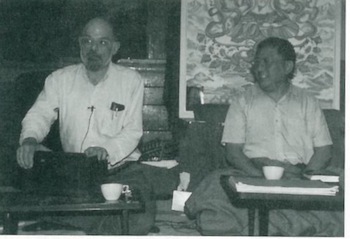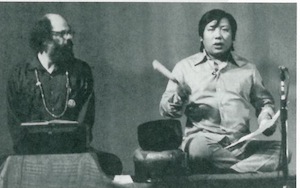Allen Ginsberg
1926–1997
Allen Ginsberg had an open life and an open death. From the time the word went out early Friday morning, April 4, that he had had a stroke and was in a coma, family, friends, lovers, poets, musicians, artists, and fellow Buddhists came to his loft on East Thirteenth Street to be with him in his final hours. Allen himself lay on a bed next to the windows that looked out on a backdrop of red taillights of cars streaming up First Avenue and the M14 buses chugging across Fourteenth Street. Above the bed were paintings, photos, and drawings, including a photograph of Walt Whitman and a William Blake lithograph, two lifelong sources of inspiration. In chairs around the bed, his “guests” took turns sitting, watching him, holding his hand, saying goodbye. One artist was drawing deathbed portraits; others were taking photographs, just like Allen himself did at events he attended or performed in. His cousin, Dr. Joel Gaidemak, listened from time to time to his heartbeat— “His heart is fine, it’s strong”—and checked his rate of respiration, and if someone wanted to know more specifically what was happening, he would open a medical text and read the medical description. Allen was lying there very peacefully, the orange flames of his Jewel Heart T-shirt visible above the blankets. With each inhalation, his head would move upward, resembling the way he would take deep breaths between lines when he read or sang his poems and songs. At Allen’s request no artificial life supports prolonged his life.
In the center of the loft, Allen’s teacher Gelek Rinpoche and a group of Tibetan monks, along with various sangha members, chanted prayers and rang bells to give Allen the last support possible. On the altar were photos of Allen’s teachers, the late Chogyam Trungpa Rinpoche and Gelek Rinpoche. Surrounding them werethankas of Vajrayogini, Yamantaka, and Chakrasamvara, and directly above hung a calligraphy of AH, painted and signed by Chogyam Trungpa Rinpoche.
At the Thirteenth Street end of the loft, people were arriving and leaving, talking, reading copies of some of Allen’s last poems eating Chinese takeout, and admiring large nude photographs of Allen with his lover Peter Orlovsky. Allen’s brother sat quietly, his stepmother Edith came by, the poet Bob Rosenthal, Allen’s assistant for twenty years, was there with his children, and Patti Smith brought her kids, explaining, “I thought it was important for them to be here.” In the office, amidst phone calls and faxes being sent and received, a Thelonius Monk CD played softly.
One week before, on Saturday, March 29, Allen had been told he had terminal liver cancer. He began making phone calls: “This is Allen Ginsberg. I have to report that I have incurable cancer.” He called Gelek Rinpoche in Ann Arbor and said, “The doctor says I have one to four months, but judging by my weakness, I don’t think I have that long.” He said to Rinpoche, adding, “I hope you’ll be around for a long, long time.”
A few years before Allen had told Philip Glass, “I still have a fear of dying. All my life I’ve been studying and I’m still afraid.” But for the past year Allen had been preparing to die, receiving instruction in specific practices for the dying process. And when he learned of his inoperable cancer, he told his teacher, later that day, “I’m amazed at how calm I was.” Allen spent his last week writing poems, calling friends, taking care of his many obligations, making sure that anyone who needed help received it. Gelek Rinpoche says, “After Allen got the news, he began the celebration of his death. Compassion was the principle of his life, without his using the word compassion, and all of his life was totally dedicated to positive causes. That builds a tremendous amount of positive karma.”

Late Friday night, from 10:30 to midnight, Gelek Rinpoche, Tibetan monks, and sangha members performed the Lama Chopa practice [the integration of the primordial enlightened mind through guru yoga] and the Chakrasamvara practice [which leads to the state of non-duality]. At 2:39 a.m., in the company of family and friends, Allen’s body gave a little jiggle, he opened his eyes, then closed them and stopped breathing. This was the physical death. But as Gelek Rinpoche said, “It’s good for people to know that when you stop breathing, you’re not dead.” Gelek Rinpoche then began the Vajrayogini self-initiation. From then until 11:30 Saturday night, Allen went through the process of the dissolving of inner elements, then entered the state wherein the mind becomes connected with the mind of enlightenment. This a state is likened to that of a child being reunited with its long-lost mother. It is the merging of one’s own consciousness with the consciousness of enlightened beings. At 11:30 Saturday night, Allen’s consciousness left his body.
“At the time of death there was no negativity,” says Gelek Rinpoche. “Allen had a very successful life and a very successful death.”
On Sunday, April 6, a service was held at the Jewel Heart Center in New York. It began with the prayer “Namo Mahamudraya.” Then Allen’s body, in a wooden casket covered with colorful brocade, was rolled slowly into the room, led by a Tibetan monk burning incense and carrying a white scarf. Gelek Rinpoche placed on top of the casket five colored scarves, representing the five dakinis inviting Allen to the Pure Land. Gelek Rinpoche, the monks, and the gathered sangha members and friends then slowly performed the Lama Chopa, which was also being done at the same time at Jewel Heart branches around the world. Bob Rosenthal read “Gone Gone Gone,” which Allen had read over the phone to Gelek Rinpoche, telling him, “I’ve written a funeral poem.” After the service, guests stayed to share memories, say prayers, partake of the food offering. Together they completed the first of many ceremonies to honor a man whose life had touched so many people.
Gone Gone Gone
Allen Ginsberg
“The wan moon is sinking under the white wave and time is sinking with me, O!”
–Robert Burns
yes it’s gone gone gone
gone gone away
yes it’s gone gone gone
gone gone away
yes it’s gone gone gone
gone gone away
yes it’s gone gone gone
it’s all gone away
gone gone gone
won’t be back today
gone gone gone
just like yesterday
gone gone gone
isn’t any more
gone to the other shore
gone gone gone
it wasn’t here to stay
yes it’s gone gone gone
all gone out to play
yes it’s gone gone gone
until another day
no one here to pray
gone gone gone
yak your life away
no promise to betray
gone gone gone
somebody else will pay
the national debt no way
gone gone gone
your furniture layaway
plan gone astray
gone gone gone
made hay
gone gone gone
Sunk in Baiae’s Bay
yes it’s gone gone gone
wallet and all you say
gone gone gone
so you can waive your pay
yes it’s gone gone gone
tomorrow’s another day
gone last Saturday
yes it’s gone gone gone
gone gone gone
turned old and gray
yes it’s gone gone gone
bald & old & gay
gone gone gone
whitebeard & cold
yes it’s gone gone gone
cashmere scarf & gold
yes it’s gone gone gone
warp & woof & wold
yes it’s gone gone gone
gone far far away
to the home of the brave
down into the grave
yes it’s gone gone gone
moon beneath the wave
yes it’s gone gone gone
so I end this song
yes this song is gone
gone to kick the gong
yes it’s gone gone gone
No more right & wrong
yes it’s gone gone gone
gone gone away
Thank you for subscribing to Tricycle! As a nonprofit, we depend on readers like you to keep Buddhist teachings and practices widely available.
